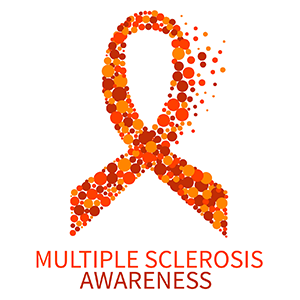March is Multiple Sclerosis Education Month. Multiple Sclerosis (MS),
although usually thought of as an adult condition, can affect children as
young as age two. It’s estimated that about 10 percent of people diagnosed
with MS experience their first symptoms before the age of 16. MS is one of
the most common diseases of the central nervous system, affecting more than
2.3 million people worldwide. Although it can be a progressive illness,
it’s not terminal. Like diabetes, it’s a chronic or long-term condition
that needs to be managed for life. Everyone’s MS is different, but most
people with MS can live a normal life span.
MS is thought to be an immune-mediated condition. This means that the
body’s immune system, which normally helps to fight off infections,
mistakes the body’s own tissue as foreign and attacks it. In MS, the immune
system attacks the myelin, the fatty material surrounding and insulating
the nerve fibers, stripping it from the nerve fibers and leaving scars
(also known as lesions, plaques or sclerosis). This damage disrupts the
messages sent from the brain that travel along the nerve fibers, causing
the messages to slow down or become distorted.
Symptoms vary widely and can include blurred vision, weak limbs, numbness,
tingling sensations, hearing loss, mood changes, cognitive difficulties,
unsteadiness and dizziness, walking difficulties, pain, fatigue and speech
impediments. Also, some people experience periods of relapse and remission,
while others experience a progressive worsening of symptoms over time. Most
children have relapsing remitting MS, with periods of good, if
unpredictable, recovery. Some children can be more severely affected, but
rapid progression is rare.
Diagnosing MS can be difficult due to its complexity and variety of
symptoms. There is no single diagnostic test for MS, but a variety of tests
can rule out other diseases that mimic MS. In addition to blood tests, an
MRI can show a detailed image of the brain and spinal cord. If there is any
damage to the myelin, the MRI can show the exact location and size of the
damage. Evoked potential testing can show the time it takes for the brain
to receive messages from the eyes, and a lumbar puncture (or spinal tap)
can show if there are any abnormalities associated with MS in the
cerebrospinal fluid.
While there is no cure for MS, medication, occupational therapy,
acupuncture and even healthy eating can help manage this complex disease.
Since symptoms vary widely in each patient, treatment combinations will
also vary.
Even if you don’t have MS, there are things you can do to help. There are
walking events in April and May in the D.C. area and biking events in June
and September. If you’d like to be involved in an event or donate, please
visit nationalmssociety.org.
Bike MS Events
- CHESAPEAKE CHALLENGE: JUNE 16
- NATION’S CAPITAL: SEPTEMBER 29
Walk MS Events
- >
- BALTIMORE, MD: APRIL 7
- BOWIE, MD: APRIL 7
- ANNAPOLIS, MD: APRIL 8
- RESTON, VA: APRIL 8
- COLUMBIA, MD: APRIL 14
- INDIAN HEAD, MD: APRIL 14
- MANASSAS, VA: APRIL 15
- TOWSON, MD: APRIL 15
- WESTMINSTER, MD: APRIL 15
- HAGERSTOWN, MD: APRIL 21
- OCEAN CITY, MD: APRIL 21
- ROCKVILLE, MD: APRIL 21
- SALISBURY, MD: APRIL 22
- FREDERICK, MD: APRIL 28
- WASHINGTON, D.C.: APRIL 29
- CUMBERLAND, MD: MAY 05
Resources:
- National Multiple Sclerosis Society: 800-344-4867
- msif.org
- nationalmssociety.org/chapters/mdm
- mayoclinic.org/multiple-sclerosis
- ninds.nih.gov/disorders/all-disorders/multiple-sclerosis-information-page
Books:
-
“Live Your Life, Not Your Diagnosis: How to Manage Stress and Live Well
with Multiple Sclerosis” by Andrea Wildenthal Hanson - “Chef Interrupted” by Trevis L. Gleason
- “Blindsided: Lifting a Life Above Illness” by Richard M. Cohen
-
“Curing MS: How Science Is Solving the Mysteries of Multiple Sclerosis” by
Howard L. Weiner, M.D. - “Multiple Sclerosis: A Guide for the Newly Diagnosed” by Jock Murray, M.D.


